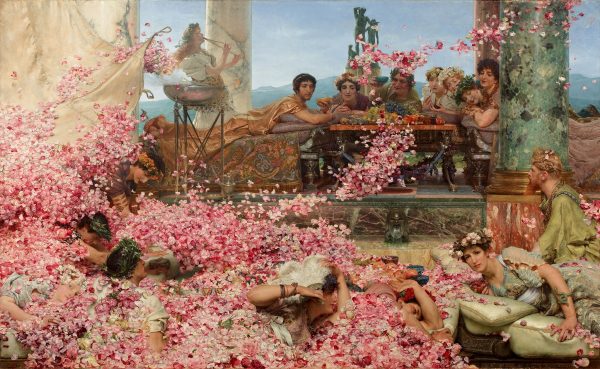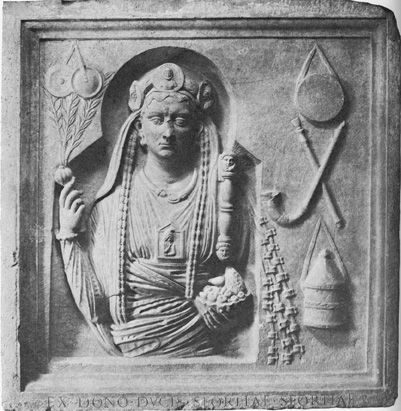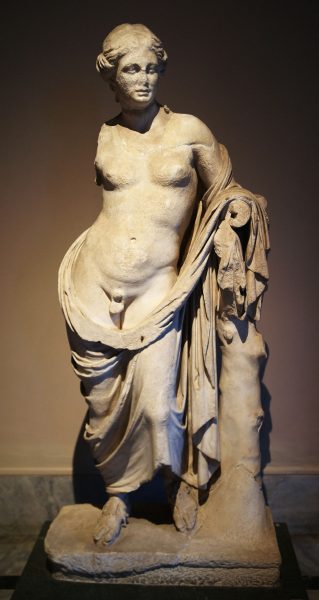The ancient Roman satirist Lucian describes an exchange between two courtesans, wherein one of the women repeatedly characterizes her lover as being “terribly like a man.” She describes their flourishing romance, and muses that her lover might be “equipped both as a man and a woman, as many people are said to be.” She says that her lover claims to be “born a woman,” but has “the mind and the desires and everything else of a man.” The interplay of sex, gender and sexuality in Lucian’s story seems to confuse modern notions of biology, identity, and orientation.
Ancient Rome featured a myriad of, what could be understood, both then and now, as experiences that transcended sex and gender norms. However, male-centered Roman society encouraged the marginalization and sensationalization of (trans)feminine expressions, identities, and non-binary sex assignments. These gender dynamics circumscribed romantic and sexual experience, and constituted both political and religious performances of power.

The amorphousness of female same-sex sexuality in Roman society is well illustrated in the story of Iphis and Ianthe by the Roman poet Ovid. Iphis is born female but raised as a boy by her mother because her father wants a son. Then, Iphis’ parents arrange for her to marry a girl named Ianthe; the pair falls in love. Iphis’ mother prays to the goddess Isis for a miracle. Her prayers are answered and Iphis is transformed into a young man. In a juxtaposition of biological and social constructions of sexual morality, this story succeeds as one about sibling incest. While the siblings’ heterosexuality is biologically ‘valid’, their love is condemned by society. Meanwhile, Iphis and Ianthe’s love is merely biologically ‘incompatible’. The couple’s happy ending is, thus, achieved through divine intervention, not through a subversion of Roman social mores.
In contrast to the elevation, in status and legitimacy, granted by masculinization or female-to-male transsexuality, sexual passivity and feminine presentation have long been stigmatized in the historiography. For instance, the famed historian Edward Gibbon described the way Roman emperor Elagabalus “abandoned [herself] to the grossest of pleasures … [and] affected to copy the dress and manners of the female sex.” In addition to depilating and wearing cosmetics, reports also claimed that Elagabalus identified as a woman—referring to herself as a “lady,” “queen,” “wife,” and “mistress,” as well as requesting to be equipped with female genitalia by her physicians. Despite Gibbon’s own antiquated social mores, as a man writing in the late eighteenth century, he conceded that reports of Elagabalus’ “vices and follies” may have been “blackened by prejudice,” such that political enemies may have taken revenge by conjuring the false image of a feminized and “deviant” tyrant.

Various Roman emperors’ feminine expressions were vilified and their sexually transgressive behavior was often interpreted as immoral. These queer performances and identities, “may have [also] been carefully calculated to communicate to Roman audiences the transcendent position and power of the emperor.” The emperor Commodus was alleged to have dyed his hair, sprinkled it with gold dust, and “dressed as a woman” for combat and visits to the amphitheater. He was also said to have proudly inscribed his Colossus remodel (himself as Hercules) with the epithet “Effeminatus.” Likewise, a statue of Marcus Aurelius was refashioned with the body of a woman. Such gender-bending imagery, and the flouting gendered conceptions of the body, may have demonstrated a likeness with or devotion to the gods.
Indeed, the practices of eunuch priests of the goddess Cybele (Galli) were integrated into Rome’s state religion. In their initiation ritual, a novice was obligated to shed his masculine attire, “castrate himself with a sword and then [run] through town with genitals in hand […] toss them into a house chosen at random, whose residents would be obligated to dress him in female attire.” This violent tradition conveyed religious devotion through the violation of sex and gender norms.

Similarly, sexed dichotomy occurred in Roman painting and sculpture of deities. Hermaphroditism, though pejorative in modern connotations (and not the same as intersexuality), found root in religious idolatry. The gods Hermaphroditus and Aphroditos had both male and female anatomy—Hermaphroditus as a result of being merged with a water nymph, while Aphroditos was a male Aphrodite. Indeed, in some depictions, Aphroditos had a beard, male genitalia, and wore women’s clothes. Both his male and female followers cross-dressed. This merging of hermaphroditism and spirituality was also domesticated, as hermaphroditic statues were featured prominently in areas like the garden of the Roman home. Such imagery was deployed as a means of constructively expressing sexual tension within a familial setting.
However, individuals who were born outside of the binary social construction of biological sex were shunned. “The birth or discovery of hermaphrodites” (presumably intersex individuals) meant death “by fire or water.” And so, an irony emerged—the ‘intersexed’ bodies of deities enhanced their transcendent mysticism and could be emulated or approximated by the non-binary gender identities and expressions of their devotees, yet the birth of intersex individuals acted as bad omens and easy scapegoats. The biological manifestation of a sex that blurred and belied the gendered dichotomies of Roman society and social order was threatening. Ancient Romans’ transgressive gender performances remained circumscribed, reserved only for fiction and fantasy, spirituality and the state.
GVGK Tang is a public history MA student at Temple University with a specialization in transnational queer history and politics, nascent community-building, and identity construction. As a public historian, Tang aspires to engage the needs of disenfranchised communities and encourage inclusive, meaningful dialogues through thought-provoking media and exhibitions. Tang tweets from @gvgktang
is a public history MA student at Temple University with a specialization in transnational queer history and politics, nascent community-building, and identity construction. As a public historian, Tang aspires to engage the needs of disenfranchised communities and encourage inclusive, meaningful dialogues through thought-provoking media and exhibitions. Tang tweets from @gvgktang
Editor’s Note: In our second instalment of the Trans History Series, Tang transports us to Ancient Rome. Tang’s work tackles the entanglement of trans histories and histories of sexuality by demonstrating that Ancient Rome privileged gender deviance in myth and spirituality. Here, we see that trans histories are not temporally, or lingually, limited to the modern era. For our final instalment, coming November 28th, Emily Skidmore will be discussing labels and language in greater detail. Be sure not to miss our first post in the series, by B Camminga, on transsexuality in twentieth-century South Africa.
The series is intended to invite increased discussion of trans history at NOTCHES. We hope that readers of the blog will approach these posts as the opening gambit in a discussion to be continued. Trans histories are accepted on an ongoing basis.

NOTCHES: (re)marks on the history of sexuality is licensed under a Creative Commons Attribution-NonCommercial-NoDerivatives 4.0 International License.
Based on a work at www.notchesblog.com.
For permission to publish any NOTCHES post in whole or in part please contact the editors at NotchesBlog@gmail.com





Excuse me for commenting on a rather old blog post, but I could barely stand to read this without a foul taste in my mouth. What exactly was accomplished by writing this? I understand that the main goal was to tell the reader about more or less documented instances of transgender persons in Ancient Rome, and yet all of it seems to be put it in a strange light. The entire post is littered with presumptuous statements of how the mind of a transgender person supposedly works, what they wish for and how they perceive themselves. It’s as if the author, while telling us of these instances, is shunning the people involved at the same time. It couldn’t be helped that society, for the most part, didn’t understand someone not identifying with their assigned-at-birth sex, yet the author describes how “vile” transgender people acted or how strange some of the rituals were, and so on. Then, at the end of the article, is a blurb about how people outside of the binary in Ancient Roman times were not accepted and discriminated against. Is the author’s intention really just to state that fact, or is it to put down someone who says that, for example, they were born female but feel male – therefore, subscribing to the binary in a sense? In the same way that I, a non-binary person, am aware that there were people thousands of years before me who felt that way as well, I also am aware that the term itself and the feeling haven’t been described in literature almost at all – that leads me to my point, which is that ancient people cannot be blamed and laughed at for not knowing how to express themselves accurately. They cannot be shamed for simply saying, “I am a woman but want to be a man”, because they might not have known how to say what they really feel – or, perhaps, that is really just the extent what they felt, and it is not shame-worthy either.
I apologize for the long comment, and I am really not trying to start an argument or anything of the sort – I am just genuinely confused about the intent of this post. I hope I haven’t offended the author if their intentions were different from what I felt. I only wish that the transgender community gets the attention it deserves, and not negativity and shaming for who they are. Thank you.
I am very sorry to learn you found this post offensive and hurtful.
I have not claimed to know how people felt or perceived themselves. If you could point to specific examples of “presumptuous statements,” I would be happy to clarify. Likewise, at no point do I “shun,” “shame,” “blame,” “laugh at” or characterize any identities or traditions as “strange” or “vile.” Indeed, one of the main themes of this post is to juxtapose the way we experience or conceive of ourselves with the language we use to describe such experiences and self-conceptions, both in the past and present. Just as a native English speaker could never truly orient themselves to fully comprehend and/or describe Chinese culture in Chinese terms, people today can never completely understand the experiences of ancient Romans. I truly believe context, positionality, time, place, and language all limit our epistemologies and, therefore, the histories we can piece together. This belief is evinced in all of my work.
Even given the notion of linguistic relativity, I am actually demonstrating that ancient Romans did, in fact, understand that people do not necessarily identify with their sex-assigned-at-birth. As with other contexts throughout time and place, this experience was regulated, bound within specific societal structures, and (mis)represented by institutions such as government, religion, art and literature.
For instance, the example of intersex folks being marginalized is contrasted with the traditional celebration of nonbinary identities. Given both sex and gender are social constructs, I highlight the irony of ancient Romans shunning nonbinary biology yet fetishizing nonbinary experiences. I fail to see how this leads the reader to assume I am “putting down” trans people who identify with a binary gender – a misleading and false assumption. Alternatively, if you are alluding to the section on historian Edward Gibbon’s offensive characterizations of Elagabalus, then it is important to note I do not condone or take at face value his work and actually critique it.
Throughout this post, I have also provided numerous historical literary references, but at no point do I speak for the people involved. In fact, my analysis centers on authors’ characterizations of people who transcended gender norms, not on the people themselves. First-person narratives are rarely represented in the historical record. As such, we must critically engage those who presume to speak for us or describe our experiences – both past and present – absent our own accounts. In this way, this post (through both its content and my own positionality) subverts the cisgender gaze.
I hope this reply will alleviate your concerns. Very best wishes.
GVGK Tang, many thanks for a post which evidently different people can read in different ways. As a transsexual lesbian feminist of the Second Wave, I find it respectful in at once addressing variations in sex characteristics (specifically intersex) and gender identity or expression, and placing these things in the specific context of Roman patriarchal prejudice. To report the biases of the dominant Roman culture is not to endorse or adopt them — for example, the same prejudice against intersex or naturally sex variant bodies that in recent times is reflected in Intersex Genital Mutilation (IGM), nonconsensual surgeries and other medical abuse of intersex infants and children not yet old enough to exercise informed consent or to resist. The intersex movement to abolish IGM is taking on the same prejudices that led to infanticide in the Roman world.
While I was familiar in the 1970’s with Lucian’s dialogue of the courtesans about lesbianism, your presentation does add the aspect of physical sex characteristics or gender identity as well as “love between women.” Modern concepts as a “Butch-FTM border” or the like, as explored by writers such as Judy/Jack Halberstam, may be related to this kind of ambiguity.
Quickly I might also mention that Ovid’s story of Iphis and Ianthe is the basis for such medieval and early modern European literature as the 13th-century French story of Ide and Olive (part of the _Romance of Huon of Bordeaux), which exists in a number of versions including a 16th-century English translation; and the play _Galathea_ (or Gallathea) by John Lyly in Elizabethan times.
Again, I realize that sometimes what a writer describes (e.g. Roman patriarchy with its fear of intersex and devaluing of the feminine or transfeminine) may be confused with the writer’s own views. But I read you as supportive of intersex, trans, and gender variant people, as does another person who is intersex and trans and posted a link to this article to show that such human experiences are not new.
I am brought to this post by way of indirect referral based upon a yet to be provided commentary to the Pope’s recent ‘published observation’ the ‘[G]od’ could never have intended individuals to choose a gender distinct from their biological or birth gender simply because of the 2d creation of story of humanity, namely, male and female He created them vs. the better known story that Eve was taken from Adam’s rib. It is perhaps ironic that both versions could have occurred simultaneously without any conflict, though a bit of humor occurs in medical school in a text I used, namely, Squire on X-Ray [I believe … its been a long time for me.] The first challenge is double shot X-ray showing a head on and lateral view of a PERSON from the waist to the neck followed by the Question … what is the sex of the person in the X-ray. What happened is well over 50% of the class remembered that Eve was supposedly created from one if Adam’s ribs … and so began lesson #1. All rib counters noticed an even number of ribs, so the X-ray had to be of a female, since there are no ‘missing ribs.’ LOL
In actuality men and women each have the same # of ribs, which may have lead to the possibility that [G]od took only a portion of Adam’s rib, namely, Adam’s DNA. Only after the firsr class is almost over, does the instructor point out two darker largely round areas, a.k.a. breasts, on the upper portion of the X-rays. These days, breast implants and female hormones would also need to be considered and ruled out, as would a child’s X-ray as would the X-ray of a M to F.
Awesome writing! Thanks for shareing this post here.